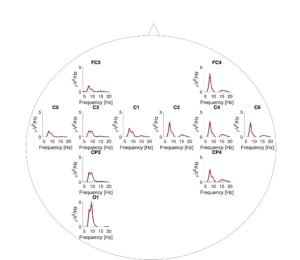Effects of mirror box therapy on modulation of sensorimotor EEG oscillatory rhythms
Investigators: R. Rosipal, N. Porubcová, Z. Rošťáková
Mirror therapy is a new tool for the rehabilitation of damaged motor pathways and functions of patients after a stroke. It is based on visual feedback imitating the movement of the injured limb. In the study we have shown that mirror therapy is associated with prolonged changes in the brain’s electrical activity. Using accurate measurements and a new methodology for extracting oscillatory EEG components, we have demonstrated in a patient following an ischemic stroke that therapy induced long-term changes in motor oscillatory rhythms, in particular a significant increase in motor mu-rhythm recorded in both hemispheres. This is a completely new, yet unpublished knowledge indicating that therapy improves impaired motor skills not only at the behavioral level, but also leads to changes in brain plasticity and provides an objective neural correlate of the effect of therapy. The methodology was developed and applied in the field of EEG signal processing and also in the construction of models controlling the robotic arm system designed for efficient motor neurorehabilitation.
Related projects:
- APVV-0668-12
- VEGA-2/0011/16

Fig.: Averaged harmonic part of the EEG frequency spectrum during a relaxed state with eyes closed before exercise (black line) and after exercise (red line). Values are averaged for all available days (51) and for each of the 11 EEG electrodes used.
Publications:
- ROSIPAL, Roman – PORUBCOVÁ, Natália – BARANČOK, P. – CIMROVÁ, B. – FARKAŠ, I. – TREJO, L.J. Effects of mirror-box therapy on modulation of sensorimotor EEG oscillatory rhythms: A single-case longitudinal study. In Journal of Neurophysiology, 2019, vol. 121, no. 2, p. 620-633. ISSN 0022-3077. (2.614-IF2018) Q1
- ROŠŤÁKOVÁ, Zuzana – ROSIPAL, Roman. Profiling continuous sleep representations for better understanding of the dynamic character of normal sleep. In Artificial Intelligence in Medicine, 2019, vol. 97, p. 152-167. ISSN 0933-3657. (3.574-IF2018) Q1
- ROŠŤÁKOVÁ, Zuzana – ROSIPAL, Roman. Three-way Analysis of Multichannel EEG Data Using the PARAFAC and Tucker Models. In Proceedings of Measurement ’19, Manka J., Svehlikova J., Witkovsky V., Frollo I. (eds.), Smolenice, Slovakia, pp. 127-130, 2019. Ocenené cenou: The Young Investigator Award.
- Reportáž VaT (Veda a Technika) RTVS 26/10/2019. https://www.rtvs.sk/televizia/archiv/14067/201880
 Contacts
Contacts Intranet
Intranet SK
SK